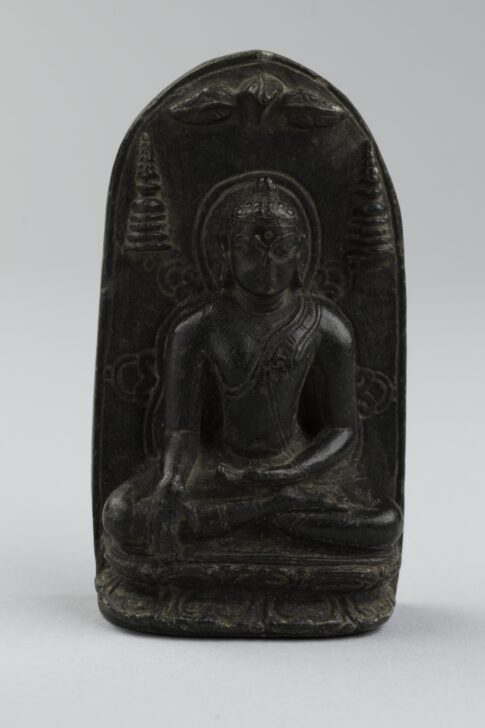Buddha, seated under a canopy of 3 leaves on a double lotus dais in the padmasana pose, in bhumisparsa mudra, flanked by two stupas
Indian

Description
The founder of Buddhism is known as Shakyamuni, the “sage (muni) of the Shakya clan.” He is shown here in the gesture of bhumisparsha mudra, or “calling the earth to witness.” The pose is based on a moment in his life when, as he sat down to meditate in a grove at Bodh Gaya, he was challenged by the evil Mara, who questioned his qualifications to earn enlightenment. Shakyamuni reached down with his right hand to touch the Earth, the sole witness of the countless past lives through which he had accumulated merit.
The two small objects to either side of the Buddha are stupas, reliquaries that house his physical remains and symbolize his nirvana, or release from the bonds of transmigration. This small image may have been carved in Bodh Gaya as a souvenir for pilgrims to the site. (A similar scene is depicted in a terracotta plaque (1990/1.176) in the UMMA collections.)
Exhibited in "Divine Encounters, Earthly Pleasures: Twenty Centuries of Indian Art," 12/12/03-2/22/04.
Subject Matter:
The founder of Buddhism is known as Shakyamuni, the “sage (muni) of the Shakya clan.” He is shown here in the gesture of bhumisparsha mudra, or “calling the earth to witness.” The pose is based on a moment in his life when, as he sat down to meditate in a grove at Bodh Gaya, he was challenged by the evil Mara, who questioned his qualifications to earn enlightenment. Shakyamuni reached down with his right hand to touch the Earth, the sole witness of the countless past lives through which he had accumulated merit.
The two small objects to either side of the Buddha are stupas, reliquaries that house his physical remains and symbolize his nirvana, or release from the bonds of transmigration. This small image may have been carved in Bodh Gaya as a souvenir for pilgrims to the site.
Physical Description:
The Buddha in bhumisparsa mudra (the gesture of touching the earth with his right hand, palm inward), signaling his victory over Mara. He is shown under three leaves, indicating the bodhi tree under which he sat while meditating before reaching an awakening. He is shown flanked by two stupas, or reliquary monuments, symbolizing his attainment of nirvana.
Usage Rights:
If you are interested in using an image for a publication, please visit https://umma.umich.edu/request-image/ for more information and to fill out the online Image Rights and Reproductions Request Form.